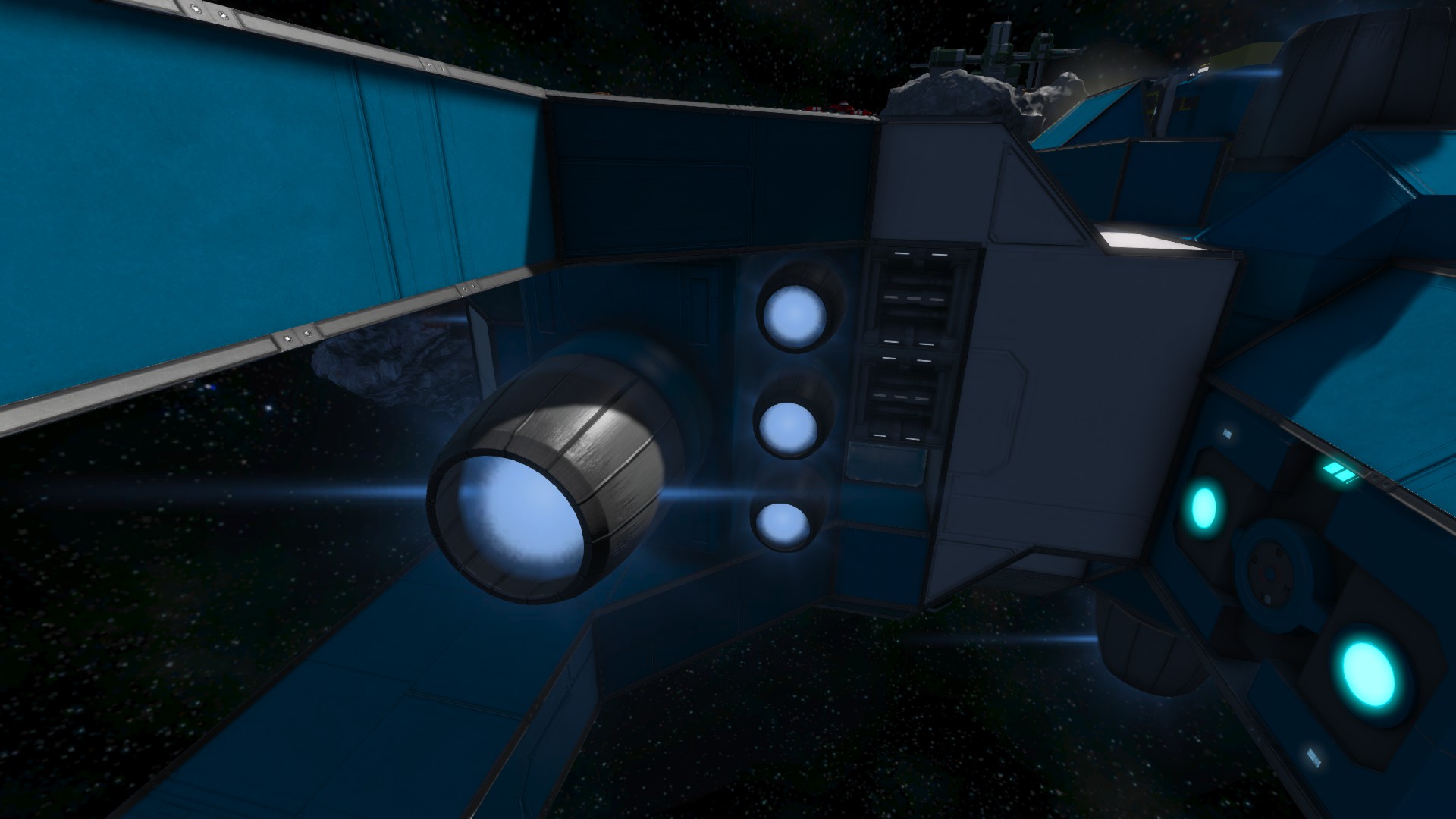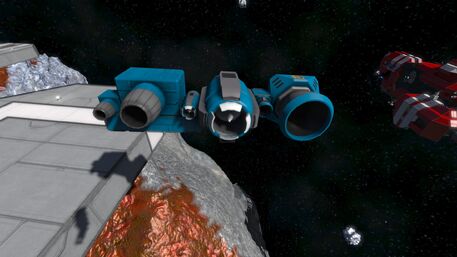Space engineers атмосферный нф ускоритель что это
Обновлено: 05.07.2024
(Заблокирован) 25 фев. 2020 в 22:05
я построил станцию. на ней 8 больших ионных движков и 44 больших атмосферных движка. Энергии хватает. Но при посадке с орбиты на землю станция падает, а турбины никак не работают. я полагаю 44 больших турбины могут хотя бы удержать 700 000 килограмм в атмосфере.
Проверял только в одиночке, на серваке такую станцию я буду строить около недели.
Спасибо за Ваше внимание, надеюсь найти решение проблемы.
25 фев. 2020 в 23:36
Турбины имеют особенность. Тяга уменьшается с высотой. Так, на 0 км от уровня моря тяга 100% на 5км - 50%. На 9.5 км уже фактически отсутствует. Это актуально для земной атмосферы. На спутниках с атмосферой, марсе, планете чужих цифры другие, но принцип тот же. Типа разряжение воздуха. Объясняется так. Таким образом, атмосферные движки такую дуру на высоте удержать не могут, а у земли уже не успевают подхватить падующую базу.
У ионных двигатеелей обратная особенность. Тяга с высотой падает начиная с 20км. У земли тяга составляет 30% он номинальной.
А вот водородные движки всегда работают на 100% (если прехватом тяги не установленно иное)
Space engineers атмосферный нф ускоритель что это


Space Engineers
9 янв. 2018 в 16:02 обьясните пожалуйста + и - водородных двигателей и в каких случаях их надо ставить+ дают отличную тягу как в атмосфере, так и в космосе
+ имеют меньший размер по сравнению с атмосферными (это если играешь на планете)
+ не жрут энергию
- нужно мастерить систему подачи водорода к каждому движку
- жрут много льда
В целом, актуально использовать их на кораблях, которым нужно покинуть атмосферу.
Атмосферные движки не могут поднять корабль выше
10км от поверхности планеты, потому дальше либо ионные либо водородные.
9 янв. 2018 в 20:46+ дают отличную тягу как в атмосфере, так и в космосе
+ имеют меньший размер по сравнению с атмосферными (это если играешь на планете)
+ не жрут энергию
- нужно мастерить систему подачи водорода к каждому движку
- жрут много льда
В целом, актуально использовать их на кораблях, которым нужно покинуть атмосферу.
Атмосферные движки не могут поднять корабль выше
Atmospheric Thruster

Atmospheric Thrusters only operate in planets with atmospheres as the name implies. They are the most efficient source of thrust in an atmosphere. However, their main disadvantage is the futility of using them in space. If an Engineer should choose to build them on their vessel in space it is recommended that their power be switched off.
The Small Ship Large Thruster has less Thrust per Block as the Small Thruster. But there is a really high Energy aspect. For the Thrust of one Large Thruster you need 5.25 Small Thruster - we take 5. Now you need 2.4 MW for one Large Thruster and 3.5 MW for 5 Small Thruster. Feel free to build compact but keep in mind that it will take more Power.
* The Exhaust Destruction "Hit-Box" describes the region in which Blocks are damaged. (tested with Light- and Heavy Armor Blocks, result may differ depending on the Armor Value of the given Block)
** The Thrust Values are based at the override function of the Thruster and what is displayed there.
*** The Power Requirement is measured by placing a Reactor, Cockpit and one Thruster, then start override to maximum and read how much percent of the Reactor is used. I know this is not really accurate but i think the Values are still representative.
Recipe
The chart below is for regular size Atmospheric Thruster for large grids and small grid vehicles.
The chart below is the Large version of the Atmospheric Thruster for large grids and small grid vessels.
Ion Thruster
Ion thrusters were the original "Thrusters" of Vanilla Alpha Space Engineers, now renamed as 'Ion thrusters'. These thrusters use only electricity to provide propulsion to their vessels and are at their best in a vacuum.

Since newer Space Engineers versions have added two other kinds of thrusters, Keen Software House decided to make these thrusters "more-end-game orientated." With that in mind, they renamed them to Ion thrusters, and required them to be made using Thruster Components, making them expensive and tedious to craft in the early game. However, once built, Ion thrusters provide efficient and fuel-free propulsion as long as there is a source of power on the grid they are attached to, and are ideal for ships operating in space.
Compared to Atmospheric Thrusters and Hydrogen Thrusters, Ion thrusters provide slightly less force (under ideal conditions) and draw more Energy from their power supply. However, unlike Atmospheric thrusters which can only work in an atmosphere, Ion thrusters work best in a vacuum, and grow significantly less powerful as they enter thicker atmospheres.

Ion thrusters' compact design gives them more surface areas for connecting other blocks, making them a lot easier to design and build around compared to the round Atmosphereic thrusters or conveyor-dependent Hyrodgen thrusters. Ion thrusters for small grids have the smallest mass compared to their counterparts, however the inverse is true for Large grids; large grid Ion thrusters are bigger and heavier than their sister thrusters.
Types of thrusters:
In real life, Ion thrusters are used by spacecraft such as the Dawn probe by exciting charged molecules to produce thrust. Currently, they are favored for long-distance craft due to their fuel efficiency and reliability. However, unlike in Space Engineers, most current and practical forms of ion propulsion consume some manner of fuel. They also make common appearances in many contemporary fictional settings as a slower but more efficient or reliable form of propulsion.
Читайте также:

